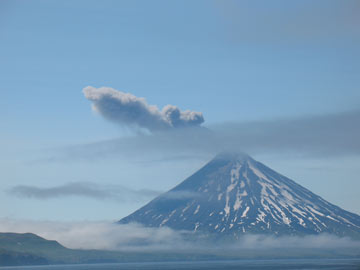|
NEWS NOTES
Volcanoes
Analyzing volcanic ash risk
 Photo courtesy of Doug Dasher, ADEC and Max Hoberg, School of Fisheries, UAF |
| Alaska’s Cleveland Volcano spewed ash several hundred meters above its summit in July, prompting aviation warnings. Ash can also affect people on the ground, and a new study helps emergency responders determine when the ash is a danger. |
For years, emergency responders have struggled to determine whether particles from volcanic ash in the air are small enough to enter humans’ lungs, triggering asthma attacks and other respiratory problems. Although most ash particles are too large to cause respiratory problems (see Geotimes, November 2007), some are not, and emergency responders need to communicate the health risks. Basic sieves used to determine rock particle size have existed for years, but in many countries, these sieves can’t accurately determine if ash particles are small enough to impact health. Now, Claire Horwell of Durham University’s Institute of Hazard and Risk Research in the United Kingdom has devised a technique to accurately measure the grain size of ash particles. Horwell developed a formula to estimate the volume of particles that could be inhaled from what can be determined through basic sieving. It’s a cheap, quick and easy method to determine whether the ash poses a danger, Horwell suggested in the Journal of Environmental Monitoring in October.
Links:
"Danger Lurks Deep: The Human Impact of Volcanoes," Geotimes, November 2007

 Subscribe
Subscribe


